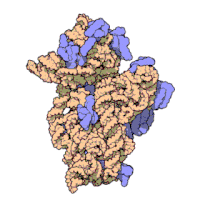
Photo from wikipedia
Based on the structural complexity of ribosomes, 16S rRNA genes are considered species-specific and hence used for bacterial phylogenetic analysis. However, a growing number of reports suggest the occurrence of… Click to show full abstract
Based on the structural complexity of ribosomes, 16S rRNA genes are considered species-specific and hence used for bacterial phylogenetic analysis. However, a growing number of reports suggest the occurrence of horizontal gene transfer, raising genealogical questions. Here we show the genetic interoperability and promiscuity of 16S rRNA in the ribosomes of an extremely thermophilic bacterium, Thermus thermophilus. The gene in this thermophile was systematically replaced with a diverse array of heterologous genes, resulting in the discovery of various genes that supported growth, some of which were from different phyla. Moreover, numerous functional chimeras were spontaneously generated. Remarkably, cold-adapted mutants were obtained carrying chimeric or full-length heterologous genes, indicating that horizontal gene transfer promoted adaptive evolution. The ribosome may well be understood as a patchworked supramolecule comprising patchworked components. We here propose the “random patch model” for ribosomal evolution.
Journal Title: Scientific Reports
Year Published: 2019
Link to full text (if available)
Share on Social Media: Sign Up to like & get
recommendations!